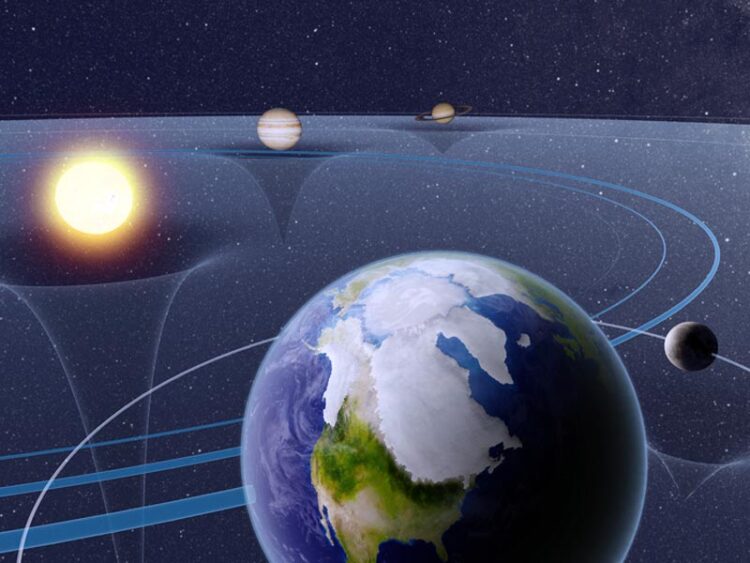Out of this world control on Ice Age cycles

Artist's impression of how astronomical forces affect the Earth's motion, climate, and ice sheets.
Credit: NAOJ
A research team, composed of climatologists and an astronomer, have used an improved computer model to reproduce the cycle of ice ages (glacial periods) 1.6 to 1.2 million years ago. The results show that the glacial cycle was driven primarily by astronomical forces in quite a different way than it works in the modern age. These results will help us to better understand the past, present, and future of ice sheets and the Earth’s climate.
Earth’s orbit around the Sun and its spin axis orientation change slowly over time, due to the pull of gravity from the Sun, the Moon, and other planets. These astronomical forces affect the environment on Earth due to changes in the distribution of sunlight and the contrast between the seasons. In particular, ice sheets are sensitive to these external forces resulting in a cycle between glacial and interglacial periods.
The present-day glacial-interglacial cycle has a period of about 100,000 years. However, the glacial cycle in the early Pleistocene (about 800,000 years ago) switched more rapidly, with a cycle of about 40,000 years. It has been believed that astronomical external forces are responsible for this change, but the details of the mechanism have not been understood. In recent years, it has become possible to investigate in more detail the role of astronomical forces through the refinement of geological data and the development of theoretical research.
A team led by Yasuto Watanabe at the University of Tokyo focused on the early Pleistocene Epoch from 1.6 to 1.2 million years ago using an improved climate computer model. Astronomical forces based on modern state-of-the-art theory are considered in these simulations. The large numerical simulations in this study reproduce well the glacial cycle of 40,000-year of the early Pleistocene as indicated by the geological record data.
From analysis of these simulation results, the team has identified three facts about the mechanisms by which astronomical forces caused changes in climate in those times. (1) The glacial cycle is determined by small differences in the amplitude of variation of the spin axis orientation and the orbit of the Earth. (2) The timing of deglaciation is determined mainly by the position of the summer solstice on its orbit, which is at perihelion, not only by the effect of periodical change of the tilt of the Earth’s axis. (3) The timing of the change in the spin axis orientation and the position of the summer solstice on its orbit determines the duration of the interglacial period.
“As geological evidence from older times comes to light, it is becoming clear that the Earth had a different climatic regime than it does today. We must have a different understanding of the role of astronomical forcing in the distant past,” says Takashi Ito from the National Astronomical Observatory of Japan, a member of this research team who led the discussion on astronomical external forces. “The numerical simulations performed in this study not only reproduce the Pleistocene glacial-interglacial cycle well, but also successfully explain the complex effects of how astronomical forcing drove the cycle at that time. We can regard this work as a starting point for the study of glacial cycles beyond the present day Earth.”
These results appeared as Watanabe Y. et al. “Astronomical forcing shaped the timing of early
Pleistocene glacial cycles” in Communications Earth & Environment on May 15, 2023.
Journal: Communications Earth & Environment
DOI: 10.1038/s43247-023-00765-x
Method of Research: Computational simulation/modeling
Subject of Research: Not applicable
Article Title: Astronomical forcing shaped the timing of early Pleistocene glacial cycles
Article Publication Date: 15-May-2023
Media Contacts
Hayao KIMURA
National Institutes of Natural Sciences
nins-kokusai@nins.jp
Office: 81-354-251-890
Hitoshi Yamaoka
NAOJ, NINS
hitoshi.yamaoka@nao.ac.jp
Original Source
All latest news from the category: Physics and Astronomy
This area deals with the fundamental laws and building blocks of nature and how they interact, the properties and the behavior of matter, and research into space and time and their structures.
innovations-report provides in-depth reports and articles on subjects such as astrophysics, laser technologies, nuclear, quantum, particle and solid-state physics, nanotechnologies, planetary research and findings (Mars, Venus) and developments related to the Hubble Telescope.
Newest articles

High-energy-density aqueous battery based on halogen multi-electron transfer
Traditional non-aqueous lithium-ion batteries have a high energy density, but their safety is compromised due to the flammable organic electrolytes they utilize. Aqueous batteries use water as the solvent for…

First-ever combined heart pump and pig kidney transplant
…gives new hope to patient with terminal illness. Surgeons at NYU Langone Health performed the first-ever combined mechanical heart pump and gene-edited pig kidney transplant surgery in a 54-year-old woman…

Biophysics: Testing how well biomarkers work
LMU researchers have developed a method to determine how reliably target proteins can be labeled using super-resolution fluorescence microscopy. Modern microscopy techniques make it possible to examine the inner workings…





















